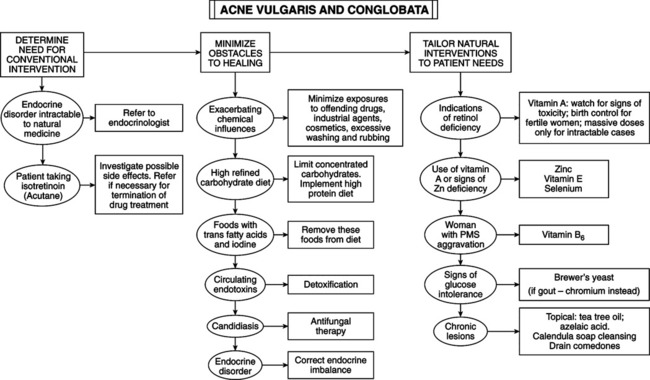• Open comedones: dilated follicles with central dark, horny plugs (blackheads) • Closed comedones: small follicular papules with (red papules) or without (whiteheads) inflammatory changes • Superficial pustules: collections of pus at follicular opening • Nodules: tender collections of pus deep in dermis • Cysts: nodules that fail to discharge contents to the surface • Large, deep pustules: nodules that break down adjacent tissue, leading to scars • Progression: hyperkeratinization of upper portion of follicle, blockage of canal, dilation and thinning, formation of comedones (open or closed based on degree of keratinization and blockage of duct), purulent exudate in pustules and cysts. • Bacteria: normal skin species (Propionibacterium acnes [Corynebacterium acnes] and Staphylococcus albus). P. acnes releases lipases, hydrolyzing sebum triglycerides into free fatty acid lipoperoxides, promoting inflammation. • Inducing compounds and habits: corticosteroids, halogens, isonicotinic acid, diphenylhydantoin, lithium carbonate, machine oils, coal tar derivatives, chlorinated hydrocarbons, cosmetics, pomades, overwashing, and repetitive rubbing. • Endocrinologic aspects: androgen-dependent condition. An-drogens control sebaceous secretion and exacerbate follicular hyperkeratinization. Endocrine disorders producing excess an-drogens induce acne development: idiopathic adrenal andro-gen excess, 21-hydroxylase, polycystic ovaries, free testosterone (T), DHEA, DHEA sulfate, deficient sex-hormone binding globulin. Skin of patient with acne has greater activity of 5-alpha-reductase, elevating more active male hormone DHT locally in skin tissue. • Diet/incidence ratio: linked to Western diet. Recommend high-protein diet (45% protein, 35% carbohydrate [CHO], 20% fat) to decrease 5-alpha-reductase activity and increase cytochrome P-450 degradation of estradiol. High CHO diet (10% protein, 70% CHO, 20% fat) has opposite effect. Limit foods high in iodine and milk (high hormone content); eliminate trans fats and high-fat foods. • Sugar, insulin, and chromium: insulin efficacy in treating acne suggests cutaneous glucose intolerance and/or insulin in-sensitivity. impaired skin glucose tolerance suggests that acne may be called “skin diabetes.” Eliminate concentrated CHOs to minimize immunosuppression. High-chromium yeast improves glucose tolerance and may help acne. • Vitamin A: retinol reduces sebum production and hyperkeratinization of sebaceous follicles. Effective at toxic dosage of 300,000-400,000 IU q.d. × 5-6 months. Toxicity: cheilitis (chapped lips) and xerosis (dry skin), especially in dry weather; headache then fatigue, emotional lability, and muscle and joint pain. Lab tests are unreliable to monitor toxicity—serum vitamin A correlates poorly with toxicity, whereas SGOT and SGPT are elevated only in symptomatic patients. Massive doses are teratogenic—women of child-bearing age must use birth control during and for at least 1 month after treatment. Reserve massive doses for intractable cases, in which it should not be used alone. • Zinc: vital to acne treatment. Involved in production of local hormones and retinol-binding protein, wound healing, tissue regeneration, and immune function. Absorption characteristics of Zn salts used may affect results; requires 12 weeks to show good results. Prefer Zn picolinate, acetate, or monomethionine. Zn is essential to normal skin function (e.g., Zn-deficient syn drome acrodermatitis enteropathica). Zn is essential for retinol-binding protein and serum retinol levels. Low Zn levels increase 5-alpha reduction of T, and high Zn inhibits this reaction. Serum Zn is lower in 13- and 14-year-old males than in any other age group. • Vitamin E and selenium: vitamin E regulates retinol levels. Male patients with acne have decreased RBC glutathione peroxidase, which normalizes with vitamin E and selenium. Acne of men and women improves with this treatment—inhibiting lipid peroxide formation—suggesting use of other free-radical quenchers. • Pyridoxine: helpful for women with premenstrual acne because of effect on steroid hormone metabolism. B6 deficiency causes increased uptake and sensitivity to T. In some patients thyroid therapy markedly improves acne. • Pantothenic acid: Active in synthesis of cholesterol and steroids. High dosages (10 g q.d. in four divided doses combined with cream consisting of 20% by weight pantothenic acid applied four to six times a day for 1-2 weeks) induce regression of lesions without side effects.
Acne Vulgaris and Acne Conglobata
DIAGNOSTIC SUMMARY
GENERAL CONSIDERATIONS

THERAPEUTIC CONSIDERATIONS
Nutrition
![]()
Stay updated, free articles. Join our Telegram channel

Full access? Get Clinical Tree


Basicmedical Key
Fastest Basicmedical Insight Engine
